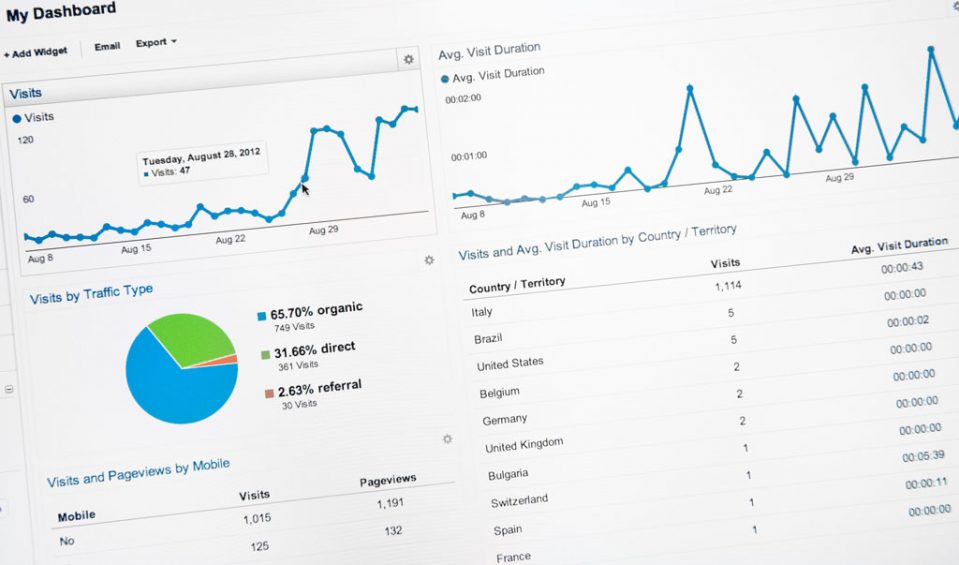It’s the end of the second quarter, do you know where your digital marketing dollars went? If you’ve been utilizing your best source of free information about your web traffic, Google Analytics, you bet your boots you do.
Tracking performance metrics in Google Analytics is the quickest, simplest way to hold your vendors accountable. But how can you tell who’s bringing the goods and who’s blowing smoke? Your Analytics automatically has all the information you need.
All aboard the vendor evaluation express train!
Open your Analytics and choose a View that contains Goals that are important to you. Navigate to your primary reporting page by clicking Acquisition > All Traffic > Source/Medium. A table will appear filled with numbers. Don’t be intimidated! You’re the conductor of this express train, and you are about to take your most lucrative route.
Before you start your train moving, check the date range on the upper right of the screen. The last 30 days is a reasonable time frame for evaluating vendor performance. Remember to click “apply” after choosing your date range. You also want to make sure you’re viewing all the of Goals in the View you’ve chosen. Just above the third column from the right is a drop-down menu called “Conversions.” This lists all the Goals contained in that View. Choose “All Goals.”
The first column on the table will be a list of your crew, aka the sources of traffic to your website. You’ll almost certainly see “Google/Organic” and “Direct,” as well as the vendors you’ve hired to drive traffic to your site. You might see sources such as “Email,” “PPC,” or “Display.” These sources will be listed in order by the number of clicks each sent to your website for the time period chosen.
The column labeled, “Sessions,” lets you know how many clicks came to your site from that source. This is your first stop on the vendor evaluation train. How did your vendors do? Did they promise a certain amount of traffic? Did they live up to that promise? Are you paying by click? Did they meet your budget? Exceed it? If they fell short of their promise, did they still charge you full price, or did you get a break on your invoice for the low performance?
Take that train to the next stop and check out each of your vendors’ “Bounce Rates.” A “bounce” is counted when a visitor makes it to your website, but then immediately leaves without engaging the site at all, so the lower the bounce rate, the better. How did your vendors do? Did 90% of their traffic bounce out? If so, you paid for a lot of worthless clicks. The internet is full of, ahem, interesting folks, who do strange and unusual things, but if your vendors are targeting the right people, they should be able to keep their Bounce Rate below 40%. If your vendor offers a Bounce Rate guarantee (there’s only one vendor I’m aware of who offers this), how did they measure up to their promise?
Your express train’s final stop will be the next to last column, “Conversion Rate.” This measures the rate at which the clicks turned into completed Goals, whether you’re hoping to measure behavioral engagement like looking at SRPs, VDPs and watching videos, or hard lead conversions through the use of forms, chat, text or click to call. Again, how did your vendors do? If they sent a lot of traffic, but no one did anything worthwhile while they were on your site, it’s likely that vendor isn’t going after the right shoppers.
Once you have enough experience as a conductor, you can take the longer, more scenic route through Analytics to help you determine if traffic is working, but total clicks, bounce rate and conversion rate are far and away the three most popular stops. Your vendors should jump at the chance to take a trip on the vendor evaluation train with you.
Any back end report can show that a vendor is the greatest thing since trains went electric. But Google is an impartial third party who is beholden to no one, and being able to measure each vendor’s performance using the same set of metrics gives you an apples to apples comparison on quality that you won’t get from any vendor dashboard.
If your final destination is more car sales, the data provided by Google Analytics can take your there.
All aboard!


